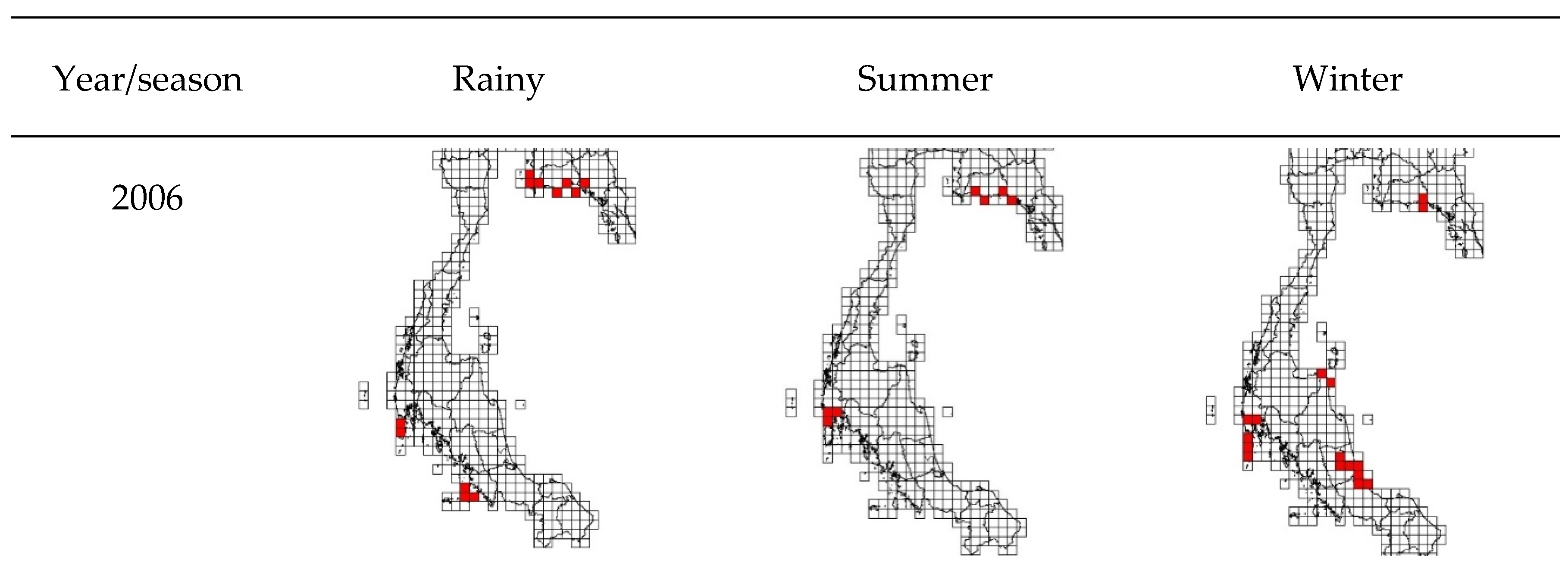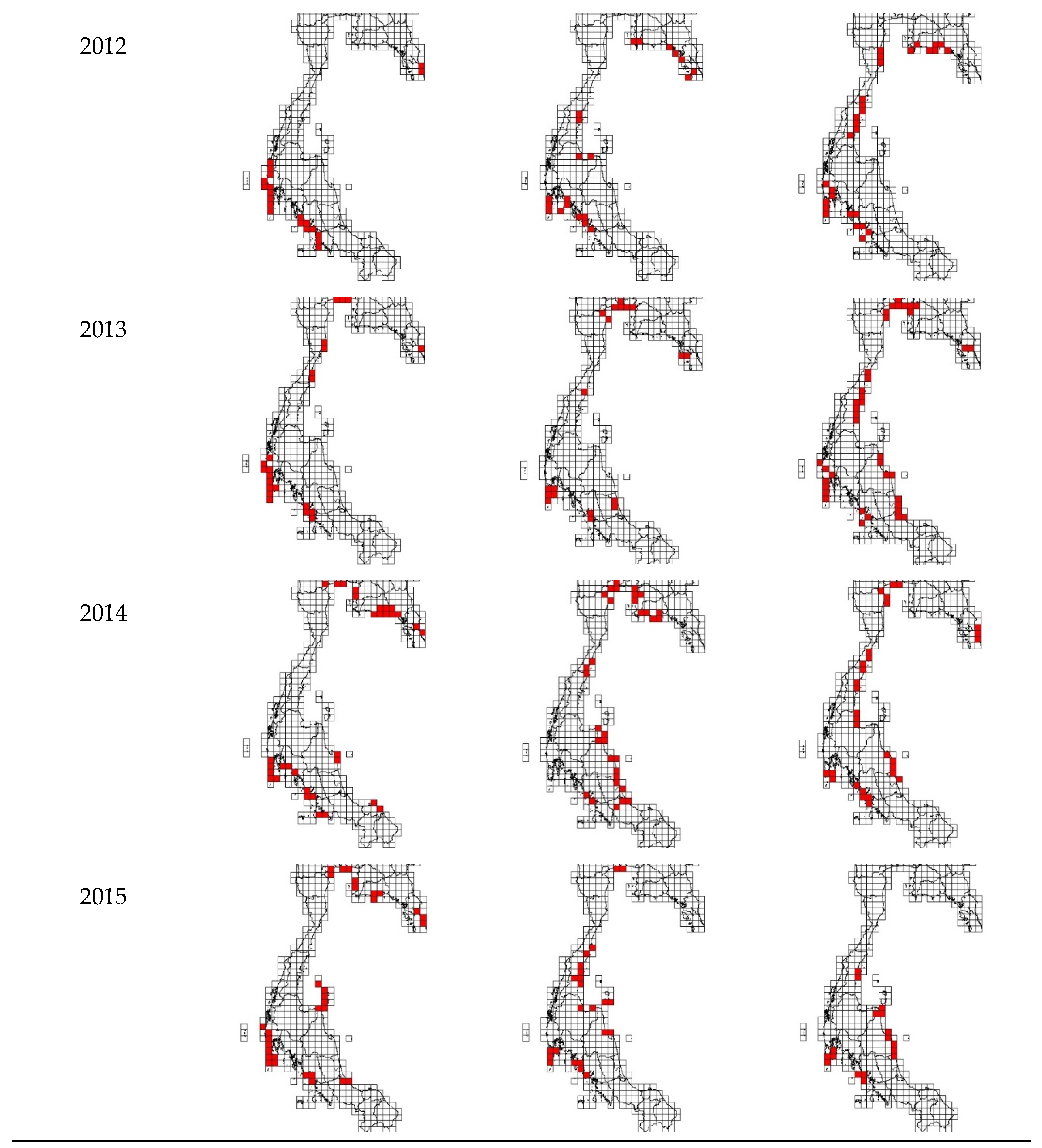Spatial, Temporal, and Geographical Factors Associated with Stranded Marine Endangered Species in Thailand during 2006–2015
Abstract
Simple Summary
Abstract
1. Introduction
2. Materials and Methods
2.1. Definition of Marine Stranding, Data Collection, and Ethical Statement
2.2. Data Manipulation and Analysis
2.2.1. Data Management and Descriptive Statistics
2.2.2. Spatial and Temporal Analyses
2.2.3. Analysis of Association of Stranding Location and Geographical Factors
3. Results
3.1. General Information
3.2. Spatial and Temporal Analyses
3.3. Factors Associated with Marine Stranding
4. Discussion
5. Conclusions
Author Contributions
Funding
Institutional Review Board Statement
Informed Consent Statement
Data Availability Statement
Acknowledgments
Conflicts of Interest
Abbreviations
References
- IUCN. Red List. Available online: https://www.iucnredlist.org/ (accessed on 12 October 2022).
- Adulyanukosol, K.; Hines, E.; Boonyanate, P. Cultural significance of dugong to Thai villagers: Implications for conservation. In Proceedings of the 5th International Symposium on SEASTAR2000 and Asian Bio-Logging Science (The 9th SEASTAR2000 Workshop), Bangkok, Thailand, 5–6 March 2009; Graduate school of Informatics, Kyoto University: Kyoto City, Japan, 2010; pp. 43–49. [Google Scholar]
- Lotze, H.K. Marine biodiversity conservation. Curr. Biol. 2021, 31, R1190–R1195. [Google Scholar] [CrossRef] [PubMed]
- Chantrapornsil, S.; Adunyanukoson, K.; Kittiwatthanawong, K. Dolphins and whales of Thailand. Warasan Kan Pram. 1996, 49, 229–247. [Google Scholar]
- Mananunsap, M.S. Status and Research on Cetaceans in Thailand, Report of the 1st Regional Workshop; SEAFDEC: Bangkok, Thailand, 2009; p. 73. [Google Scholar]
- Thongsukdee, S.; Sawangarreruks, S. Dolphin and whale surveys along the coastline of inner Gulf of Thailand. Warasan Kan Pramong. 2005, 58, 449–456. [Google Scholar]
- DMCR. Knowledge Management. Available online: https://km.dmcr.go.th/c_7/d_1812 (accessed on 12 October 2022).
- Poommouang, A.; Kriangwanich, W.; Buddhachat, K.; Brown, J.L.; Piboon, P.; Chomdej, S.; Kampuansai, J.; Mekchay, S.; Kaewmong, P.; Kittiwattanawong, K. Genetic diversity in a unique population of dugong (Dugong dugon) along the sea coasts of Thailand. Sci. Rep. 2021, 11, 11624. [Google Scholar] [CrossRef]
- DMCR. Knowledge Management. Available online: https://km.dmcr.go.th/c_10/d_935 (accessed on 12 October 2022).
- DMCR. Knowledge Management. Available online: https://km.dmcr.go.th/c_6/d_2688 (accessed on 12 October 2022).
- Adulyanukosol, K.; Chantrapornsil, S. Management of dugongs, dolphins and whales stranded and carcass management. Thai J. Fish. 2001, 54, 333–338. [Google Scholar]
- Prampramote, J.; Boonhoh, W.; Intongead, S.; Sakornwimol, W.; Prachamkhai, P.; Sansamur, C.; Hayakijkosol, O.; Wongtawan, T. Association of ocean macroplastic debris with stranded sea turtles in the Central Gulf of Thailand. Endanger. Species Res. 2022, 47, 333–343. [Google Scholar] [CrossRef]
- Cloyed, C.S.; Johnson, C.I.; DaCosta, K.P.; Clance, L.R.; Russell, M.L.; Díaz Clark, C.; Hieb, E.E.; Carmichael, R.H. Effects of tissue decomposition on stable isotope ratios and implications for use of stranded animals in research. Ecosphere 2023, 14, e4385. [Google Scholar] [CrossRef]
- National Marine Fisheries Service Endangered Species Act Section 7 Biological and Conference Opinion, Biological and Conference Opinion on the Issuance of Permit No. 24359 to the Marine Mammal Health and Stranding Response Program and the Proposed Implementation of a Program for the Marine Mammal Health and Stranding Response Program. 2022. Available online: https://repository.library.noaa.gov/view/noaa/47984 (accessed on 1 March 2023).
- Aquatic Resources Research Institute. Marine Knowledge Hub. Available online: http://www.mkh.in.th/index.php?lang=th (accessed on 25 January 2016).
- Scott, L.M.; Janikas, M.V. Spatial statistics in ArcGIS. In Handbook of Applied Spatial Analysis; Springer: Berlin/Heidelberg, Germany, 2010; pp. 27–41. [Google Scholar]
- Xu, S.; Liu, Y.; Wang, X.; Zhang, G. Scale effect on spatial patterns of ecosystem services and associations among them in semi-arid area: A case study in Ningxia Hui Autonomous Region, China. Sci. Total Environ. 2017, 598, 297–306. [Google Scholar] [CrossRef]
- Cantor, M.; Barreto, A.S.; Taufer, R.M.; Giffoni, B.; Castilho, P.V.; Maranho, A.; Beatriz, C.; Kolesnikovas, C.; Godoy, D.; Rogério, D.W. High incidence of sea turtle stranding in the southwestern Atlantic Ocean. ICES J. Mar. Sci. 2020, 77, 1864–1878. [Google Scholar] [CrossRef]
- Mghili, B.; Benhardouze, W.; Aksissou, M.; Tiwari, M. Sea turtle strandings along the Northwestern Moroccan coast: Spatio-temporal distribution and main threats. Ocean Coast. Manag. 2023, 237, 106539. [Google Scholar] [CrossRef]
- Moore, J.E.; Wallace, B.P.; Lewison, R.L.; Žydelis, R.; Cox, T.M.; Crowder, L.B. A review of marine mammal, sea turtle and seabird bycatch in USA fisheries and the role of policy in shaping management. Mar. Policy 2009, 33, 435–451. [Google Scholar] [CrossRef]
- Chanrachkij, I.; Ananpongsuk, S.; Wanchana, W. An Assessment of Fishing Gears that Contribute to Increased Sea Turtle Mortalities: A Case Study in Rayong Province, Thailand; Secretariat, Southeast Asian Fisheries Development Center: Bangkok, Thailand, 2010. [Google Scholar]
- Aragones, L.V.; Laggui, H.L.M.; Amor, A.K.S. The Philippine marine mammal strandings from 2005 to 2016. In Quezon City: Philippine Marine Mammal Stranding Network (PMMSN); The Philippine Marine Mammal Stranding Network: Subic Bay, Philippines, 2017. [Google Scholar]
- Gulland, F. Review of the Marine Mammal Unusual Mortality Event Response Program of the National Marine Fisheries Service; NOAA: Washington, DC, USA, 2006.
- Díaz-Mendoza, C.; Mouthon-Bello, J.; Pérez-Herrera, N.L.; Escobar-Díaz, S.M. Plastics and microplastics, effects on marine coastal areas: A review. Environ. Sci. Pollut. Res. 2020, 27, 39913–39922. [Google Scholar] [CrossRef] [PubMed]
- Sanchez-Vidal, A.; Canals, M.; de Haan, W.P.; Romero, J.; Veny, M. Seagrasses provide a novel ecosystem service by trapping marine plastics. Sci. Rep. 2021, 11, 254. [Google Scholar] [CrossRef] [PubMed]
- Olson, J.K.; Aschoff, J.; Goble, A.; Larson, S.; Gaydos, J.K. Maximizing surveillance through spatial characterization of marine mammal stranding hot spots. Mar. Mamm. Sci. 2020, 36, 1083–1096. [Google Scholar] [CrossRef]
- Luang-on, J.; Ishizaka, J.; Buranapratheprat, A.; Phaksopa, J.; Goes, J.I.; Kobayashi, H.; Hayashi, M.; Maure, E.d.R.; Matsumura, S. Seasonal and interannual variations of MODIS Aqua chlorophyll-a (2003–2017) in the Upper Gulf of Thailand influenced by Asian monsoons. J. Oceanogr. 2022, 78, 209–228. [Google Scholar] [CrossRef]
- Saramul, S. Seasonal monsoon variations in surface currents in the Gulf of Thailand revealed by high frequency radar. Eng. J. 2017, 21, 25–37. [Google Scholar] [CrossRef]
- Phongsuwan, N.; Chansang, H. Repeated coral bleaching in the Andaman Sea, Thailand, during the last two decades. Phuket Mar. Biol. Cent. Res. Bull. 2012, 71, 19–41. [Google Scholar]
- Ufimtsev, G. Coastal tropical morphogenesis of the Islands in the Andaman Sea (Thailand). Geogr. Nat. Resour. 2011, 32, 292–296. [Google Scholar] [CrossRef]
- Scoffin, T.; Tudhope, A.; Brown, B.; Chansang, H.; Cheeney, R. Patterns and possible environmental controls of skeletogenesis of Porites lutea, South Thailand. Coral Reefs 1992, 11, 1–11. [Google Scholar] [CrossRef]
- Gibson, R.; Atkinson, R.; Gordon, J. Coral reefs of the Andaman Sea—An integrated perspective. Oceanogr. Mar. Biol. Ann. Rev. 2007, 45, 173–194. [Google Scholar]
- Piniak, G.A.; Storlazzi, C.D. Diurnal variability in turbidity and coral fluorescence on a fringing reef flat: Southern Molokai, Hawaii. Estuar. Coast. Shelf Sci. 2008, 77, 56–64. [Google Scholar] [CrossRef]
- Saramul, S.; Ezer, T. Spatial variations of sea level along the coast of Thailand: Impacts of extreme land subsidence, earthquakes and the seasonal monsoon. Glob. Planet. Chang. 2014, 122, 70–81. [Google Scholar] [CrossRef]
- Wall, M.; Schmidt, G.M.; Janjang, P.; Khokiattiwong, S.; Richter, C. Differential impact of monsoon and large amplitude internal waves on coral reef development in the Andaman Sea. PLoS ONE 2012, 7, e50207. [Google Scholar] [CrossRef] [PubMed]
- Kulanujaree, N.; Salin, K.R.; Noranarttragoon, P.; Yakupitiyage, A. The transition from unregulated to regulated fishing in Thailand. Sustainability 2020, 12, 5841. [Google Scholar] [CrossRef]





Disclaimer/Publisher’s Note: The statements, opinions and data contained in all publications are solely those of the individual author(s) and contributor(s) and not of MDPI and/or the editor(s). MDPI and/or the editor(s) disclaim responsibility for any injury to people or property resulting from any ideas, methods, instructions or products referred to in the content. |
© 2023 by the authors. Licensee MDPI, Basel, Switzerland. This article is an open access article distributed under the terms and conditions of the Creative Commons Attribution (CC BY) license (https://creativecommons.org/licenses/by/4.0/).
Share and Cite
Pradip Na Thalang, P.; Thongratsakul, S.; Poolkhet, C. Spatial, Temporal, and Geographical Factors Associated with Stranded Marine Endangered Species in Thailand during 2006–2015. Biology 2023, 12, 448. https://doi.org/10.3390/biology12030448
Pradip Na Thalang P, Thongratsakul S, Poolkhet C. Spatial, Temporal, and Geographical Factors Associated with Stranded Marine Endangered Species in Thailand during 2006–2015. Biology. 2023; 12(3):448. https://doi.org/10.3390/biology12030448
Chicago/Turabian StylePradip Na Thalang, Pangram, Sukanya Thongratsakul, and Chaithep Poolkhet. 2023. "Spatial, Temporal, and Geographical Factors Associated with Stranded Marine Endangered Species in Thailand during 2006–2015" Biology 12, no. 3: 448. https://doi.org/10.3390/biology12030448
APA StylePradip Na Thalang, P., Thongratsakul, S., & Poolkhet, C. (2023). Spatial, Temporal, and Geographical Factors Associated with Stranded Marine Endangered Species in Thailand during 2006–2015. Biology, 12(3), 448. https://doi.org/10.3390/biology12030448





